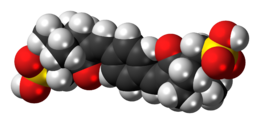
| |

| |
| Names | |
|---|---|
| IUPAC name
[(3Z)-3-[[4-[(Z)-[7,7-Dimethyl-2-oxo-1-(sulfomethyl)-3-bicyclo[2.2.1]heptanylidene]methyl]phenyl]methylidene]-7,7-dimethyl-2-oxo-1-bicyclo[2.2.1]heptanyl]methanesulfonic acid
| |
| Other names
Mexoryl SX; Terephthalylidene dicamphor sulfonic acid
| |
| Identifiers | |
3D model (JSmol)
|
|
| ChEMBL | |
| ChemSpider | |
| ECHA InfoCard | 100.101.049 |
PubChem CID
|
|
| UNII | |
CompTox Dashboard (EPA)
|
|
| |
| |
| Properties | |
| C28H34O8S2 | |
| Molar mass | 562.69 g·mol−1 |
| Melting point | 255 °C (491 °F; 528 K) (dec) [1] |
| log P | 1.35 [1] |
Except where otherwise noted, data are given for materials in their standard state (at 25 °C [77 °F], 100 kPa).
| |
Ecamsule (USAN, trade name Mexoryl SX, INCI terephthalylidene dicamphor sulfonic acid) is an organic compound which is added to many sunscreens to filter out UVA rays. It is a benzylidene camphor derivative, many of which are known for their excellent photostability.[2]
Although there are a few different UV absorbers with the trade name Mexoryl, only two of them are widely used where approved. Mexoryl SX (water-soluble) and Mexoryl XL (INCI Drometrizole trisiloxane, oil-soluble). Together they show a synergistic effect in protection.[3] The patents are held by L'Oréal. Sunscreens containing ecamsule are exclusive to L'Oréal and its brands.
- ^ a b "ecamsule". www.chemsrc.com.
- ^ Deflandre A, Lang G (April 1988). "Photostability assessment of sunscreens. Benzylidene camphor and dibenzoylmethane derivatives". International Journal of Cosmetic Science. 10 (2): 53–62. doi:10.1111/j.1467-2494.1988.tb00002.x. PMID 19456910. S2CID 35351113.
- ^ Moyal D. (October 2004). "Prevention of ultraviolet-induced skin pigmentation". Photodermatol Photoimmunol Photomed. 20 (5): 243–7. doi:10.1111/j.1600-0781.2004.00111.x. PMID 15379874. S2CID 22120937.